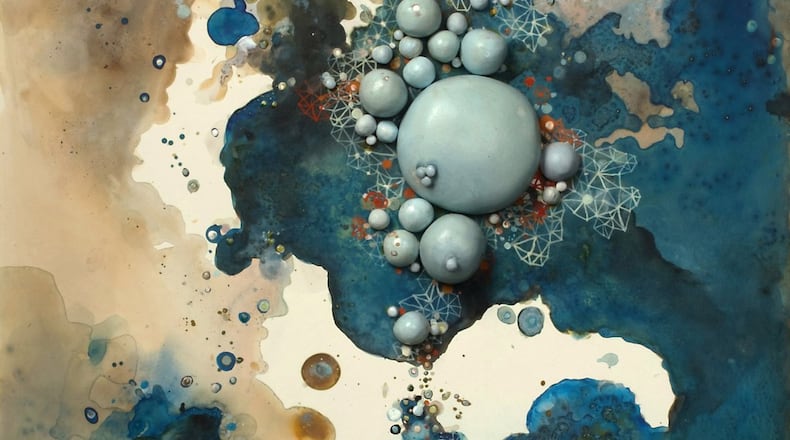ART REVIEW
“Gurgle and Seep: Laura Bell.” Through March 30. 11 a.m.-5 p.m. Wednesdays-Saturdays. Whitespace Gallery, 814 Edgewood Ave., Atlanta. 404-688-1892, www.whitespace814.com.
Bottom line: Activity and growth are themes in this solo show of charmingly odd mixed media paintings and far more interesting and compelling fabric, sculptural works.
Laura Bell’s paintings quite literally pop. The Atlanta-based artist moves two-dimensional works into three dimensions by attaching clay mounds to her paintings that cluster like small planets in a colorful solar system. Many of her paintings suggest a bird’s eye view of galaxies in formation, with clouds, particles and planets quietly churning away.
Bell has a talent for conveying tumult and flux in these static works. She achieves that impression in her clay works by creating three levels of activity — the flat, cloud-like swirls of color in the backdrop, geometric shapes that suggest more dimensionality, and finally the fully three-dimensional clay bubbles and conical shapes that burst from the painting surface.
Creation, flux, movement and transformation are the overarching themes of Bell’s solo show “Gurgle and Seep,” on view at Inman Park’s Whitespace Gallery. Sometimes that tumult seems macro, as in those solar system-evoking paintings. And sometimes the sense of flux seems more microscopic.
If the small paintings in acrylic, ink and painted clay in the gallery’s first room bring to mind solar systems, then her primarily felt and fabric works in the gallery’s largest space suggest more biological occurrences. Fabric pieces like “Pollinate” and “Sting” appear to depict the operations of teeming insect colonies, while works like “Spillover” and “Tingle” evoke the boils, sores and tumors of more intimate and small-scale activity.
The color scheme of Bell’s paintings is subdued: smoky blue-grays and rusts. But her lewdly manic fabric works — like Lady Gaga’s embroidery — are another story.
The fabric works are especially quirky with their festive, bright colors: corals, harvest golds, hot pinks, lipsticky reds. They suggest the color schemes of 1960s and ’70s pillows and wall hangings.
That sauciness in her color scheme is echoed in the way fabric tubers emerge from her paintings, as if taunting or teasing. In the gloriously complex sculptural piece “Congregate,” in felt and linen, grey tubers with cantaloupe-colored centers cluster and burst from the wall. The projections, like sea anemones or coral formations, are alive with color and suggestive activity. Some of the protrusions sport colorful beads on their surfaces, like bubbles forming from air holes, and others spew waterfalls of thread.
These fabric works, undoubtedly the most compelling in the show, have an engaging and animated spirit less evident in Bell’s clay pieces.
Bell’s work is odd, intriguing, occasionally even creepy.
In one slightly sinister, slightly goofy installation, “Lurk,” a wooden door in the gallery seems unable to contain some unseen creature: a mass of curly hair — human and synthetic — and multi-colored felt balls the size of gum balls spew from the cracks. The work is too silly and colorful to be truly disturbing.
Instead, Bell manages to walk a line between the icky and the effervescent, the silly and the strange — her work always meeting somewhere in the middle.
About the Author
Keep Reading
The Latest
Featured


